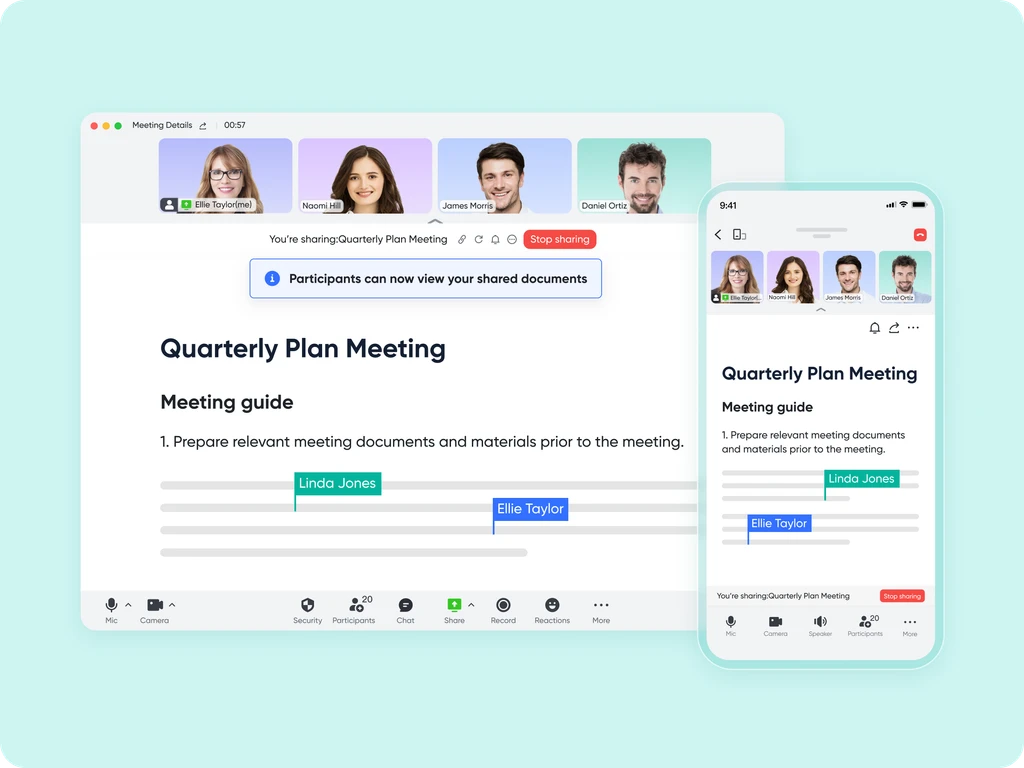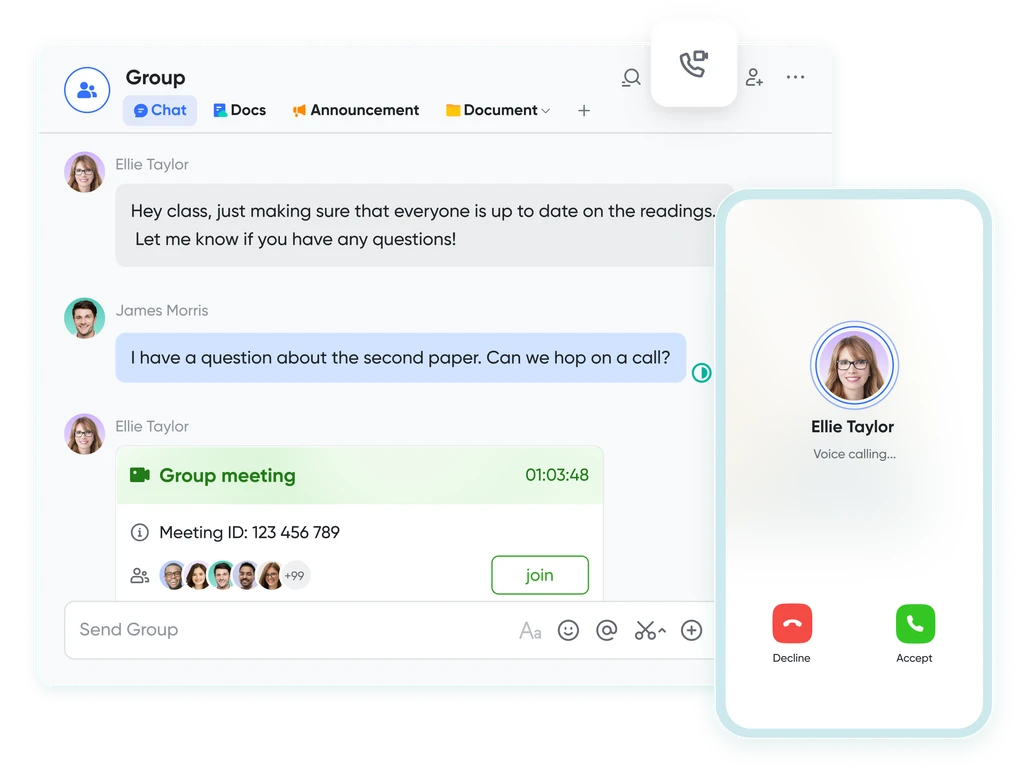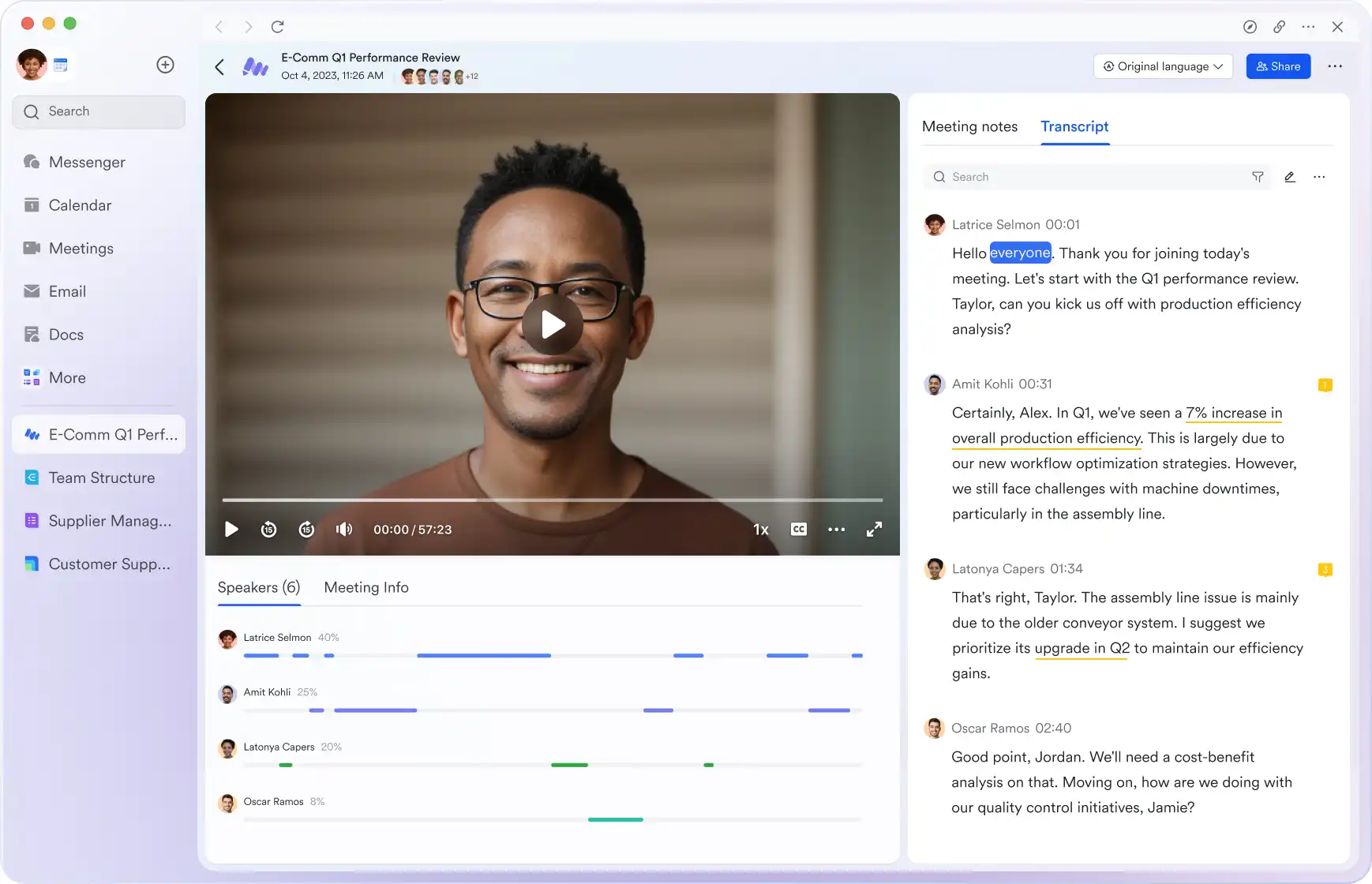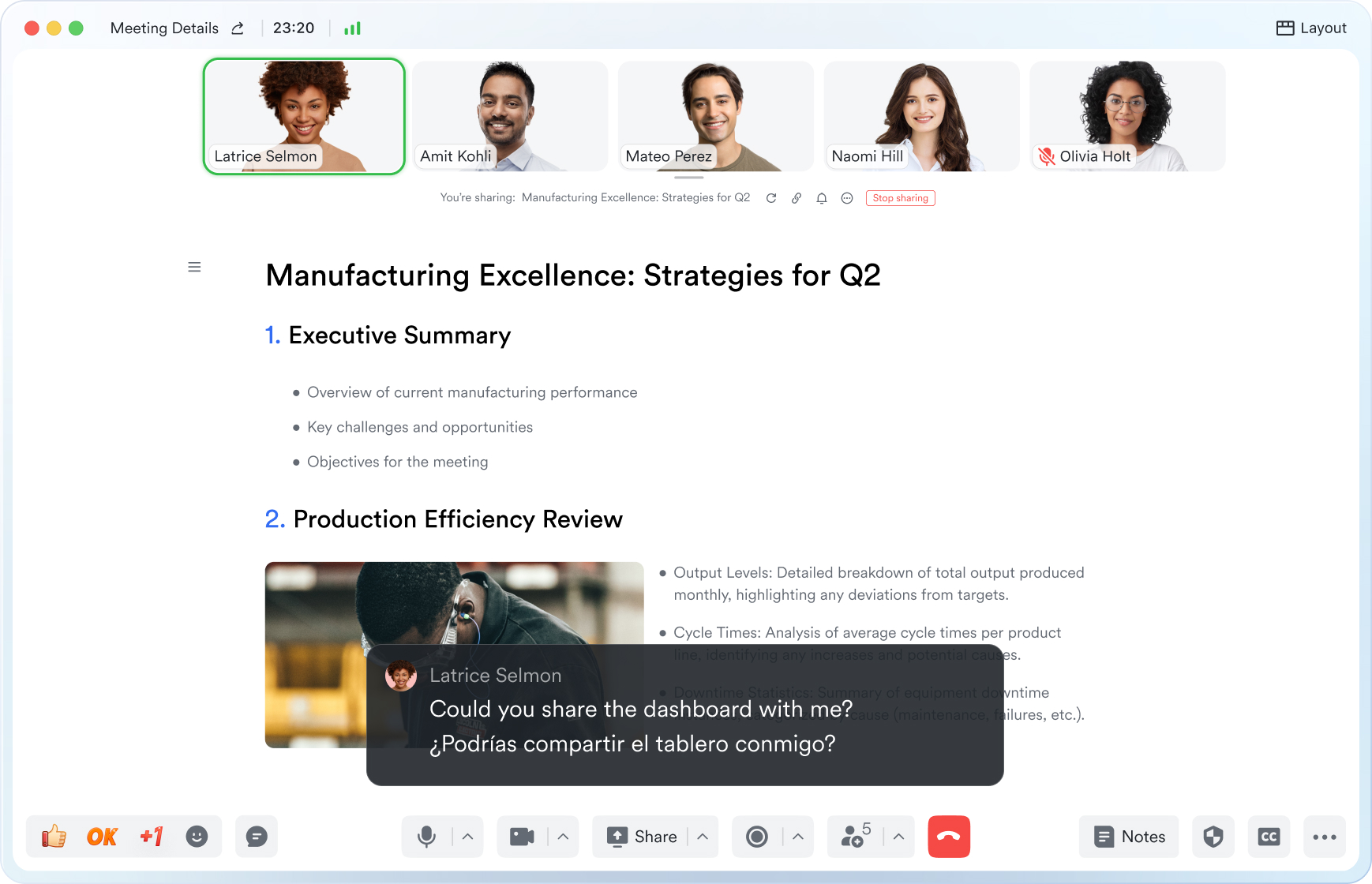Scrum Meeting
This guide will walk you through the essential elements of use scrum meeting to keep your attendees aligned and engaged.
Try Lark for Free
Scrum meetings, a fundamental aspect of Agile project management, provide teams with a structured framework for collaboration, communication, and progress tracking. These short, time-boxed gatherings are designed to keep teams aligned, focused, and adaptable. In this comprehensive guide, we'll explore the world of Scrum meetings, their significance, and how to conduct them effectively to drive project success.
Use Lark Meetings to turn meetings into true collaborative experiences.
What is a scrum meeting?
Understanding Scrum Meetings
A Scrum meeting is a daily stand-up meeting that brings together members of an Agile team to discuss progress, challenges, and plans. These meetings follow a set structure and are typically brief, aiming to keep the team informed and identify any obstacles that may hinder project progress.
Goals of a scrum meeting
Driving Collaboration and Removing Obstacles
The primary goals of a Scrum meeting include:
- Alignment: Ensuring team members are aligned with project goals and priorities.
- Collaboration: Encouraging communication and collaboration among team members.
- Obstacle Identification: Identifying and addressing impediments to progress.
Who should attend a scrum meeting?
Key Participants
Scrum meetings involve the following key participants:
- Scrum Team: Comprising developers, testers, and other relevant team members.
- Scrum Master: The facilitator responsible for ensuring the Scrum process is followed.
- Product Owner: Representing the stakeholders and the project's business objectives.
Learn more about Lark x Meetings
Topics, agenda, and structure of a scrum meeting
Structuring the Meeting
A Scrum meeting follows a structured agenda that includes the following components:
- Daily Stand-Up: Team members provide updates on their work since the last meeting.
- Obstacle Identification: Team members identify any challenges or impediments.
- Planning and Coordination: Discussions on how to move forward and plan the day's work.
- Time-Boxed: The meeting is kept short and focused, typically lasting 15 minutes or less.
How to conduct an effective scrum meeting?
Step-by-Step Guide
Conducting an effective Scrum meeting requires adherence to best practices and a well-defined process. Follow these steps for a successful Scrum meeting:
- Set a Regular Time: Schedule the Scrum meeting at the same time and location every day.
- Stand Up: Participants stand to encourage brevity and keep the meeting concise.
- Follow the Three Questions: Each team member answers three questions: What did I accomplish yesterday? What will I do today? Are there any obstacles in my way?
- Focus on Impediments: If obstacles are identified, the team discusses how to remove them.
- Limit Side Conversations: Keep the meeting focused on the agenda and avoid tangential discussions.
- Use Visual Aids: Consider using a physical or digital board to visualize progress.
- Document Action Items: Ensure that any action items or tasks assigned during the meeting are recorded.
- End on Time: Conclude the meeting promptly to respect participants' schedules.
Learn more about Lark x Meetings
How often should you hold scrum meetings?
Meeting Frequency
Scrum meetings are held daily, typically at the same time each day. Their frequent occurrence ensures that teams remain synchronized, adaptable, and able to address issues promptly.
Key differences between scrum meetings and similar meetings
Understanding Distinctions
Scrum meetings have unique characteristics that distinguish them from other types of gatherings:
- Daily Frequency: Scrum meetings occur daily to maintain continuous alignment.
- Brief Duration: These meetings are intentionally short, ensuring they do not disrupt work.
- Focus on Progress: The primary focus is on progress updates and obstacle removal.
Related:
Unlock the Power of Webinars: A Comprehensive Guide to Boost Your Business | Lark Blog | Lark BlogLearn more about Lark x Meetings
Common pitfalls of scrum meetings
Avoiding Mistakes
To ensure the success of Scrum meetings, be cautious of these common pitfalls:
- Lack of Preparation: Team members are unprepared or do not have their updates ready.
- Overly Technical Discussions: Delving into technical details that are not relevant to the whole team.
- Inadequate Obstacle Resolution: Identifying obstacles but failing to address or assign responsibility for resolving them.
Tips for maximizing the impact of scrum meetings
Enhancing Effectiveness
To make the most of Scrum meetings, consider implementing these tips:
- Stick to the Agenda: Ensure that the meeting remains focused on the three key questions.
- Encourage Transparency: Foster an environment where team members feel comfortable sharing updates and obstacles.
- Proactive Obstacle Resolution: Address obstacles promptly to prevent project delays.
- Continual Improvement: Regularly review the effectiveness of Scrum meetings and make adjustments as needed.
Learn more about Lark x Meetings
Examples
Real-world scenarios
Real-world scenarios
Let's explore three real-world scenarios of successful Scrum meetings in various contexts:
Scenario 1: Software Development Scrum Meeting
Brief Content: A software development team conducts daily Scrum meetings to discuss progress on a mobile app development project. The meetings occur in the team's workspace, with each member providing updates.
Detailed Content: Each team member stands in a circle and answers the three Scrum questions. They share what they accomplished yesterday, what they plan to do today, and any obstacles they face. The team discusses potential solutions to obstacles and assigns action items as needed. The brief and focused nature of the meeting ensures that team members remain aligned and aware of each other's progress.
Scenario 2: Marketing Campaign Scrum Meeting
Brief Content: A marketing team holds daily Scrum meetings to coordinate efforts on an upcoming product launch campaign. These meetings take place virtually, with team members joining from different locations.
Detailed Content: Team members join a video conference call and follow the same Scrum format. They share updates on campaign progress, tasks completed, and any challenges they've encountered. The team collaboratively addresses issues, adjusts strategies as needed, and assigns tasks for the day. Despite being conducted virtually, these Scrum meetings maintain the team's focus and alignment.
Scenario 3: Agile Project Management Scrum Meeting
Brief Content: An Agile project management team conducts Scrum meetings as part of their project planning and execution process. These meetings are held in a dedicated Scrum room at the same time each day.
Detailed Content: The team gathers in the Scrum room, where they have a physical board to visualize project progress. Each member stands at the board and provides their updates, adhering to the three Scrum questions. The board is updated with tasks completed and any obstacles identified. The team discusses how to tackle impediments, redistributes tasks as necessary, and ensures that everyone is on the same page regarding project goals and priorities.
Tips for do's and don'ts
Best Practices and Pitfalls to Avoid
Follow these do's and don'ts to ensure productive and effective Scrum meetings:
| Do's | Don'ts |
|---|---|
| Hold Scrum meetings at the same time and location daily. | Don't allow Scrum meetings to become lengthy or drift off-topic. |
| Encourage active participation and honest sharing of updates. | Avoid assigning blame or focusing on individual performance during the meeting. |
| Promptly address identified obstacles and impediments. | Neglect to update the Scrum board or track action items from the meeting. |
| Use the Scrum meeting as an opportunity for continuous improvement. | Disregard the importance of time management and punctuality in Scrum meetings. |
Use Lark Meetings to turn meetings into true collaborative experiences.
A Game Changer for Scrum Meeting: Empower your team with Lark Meetings
In the fast-paced and dynamic world of modern business, effective communication and collaboration are crucial for success of Scrum Meeting. Here we introduce Lark Meetings to serve as a centralized hub for all communication needs.
Transform your meetings into collaborative endeavors

Leverage the potency of in-call document sharing, intelligent meeting minutes, and mobile-optimized features to enhance productivity collaboratively, irrespective of your location or schedule.
Seamlessly collaborate in real-time, across any device

Share live documents instead of just screen views. Participants can navigate and edit simultaneously within the video call window, even while on the move.
Shift your focus to engagement, not note-taking

Lark Minutes automatically converts video meetings into transcripts, facilitating easy viewing, searching, and collaborative editing. Stay in the loop asynchronously, even if you can't attend the live meeting. Lark Minutes for meeting minutes support translation into 10+ different languages.
Break language barriers in communication

Lark Meetings provide real-time translation for subtitles, allowing individuals from diverse backgrounds to express themselves in their native languages. Ensure every voice is heard, regardless of geographical location. Live subtitles currently support translations from English, Chinese, and Japanese to 10+ different languages. See more translation feature in Lark.
Connect with larger audiences
Host dynamic online meetings and events accommodating up to 1,000 participants, with the flexibility of up to 50 breakout sessions for intimate group discussions within the larger meeting context. Try more Lark features for free.








